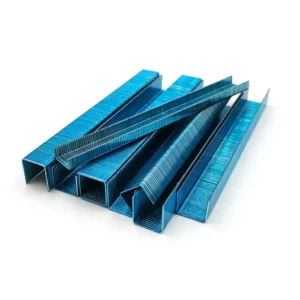18 gauge crown staples are a type of fastener commonly used in woodworking and furniture construction. They are made from steel wire and have a crown width of ¼ inch (6.35 mm).
Here are some key features and benefits of 18 gauge crown staples:
Versatile: 18 gauge crown staples are a versatile fastener that can be used for a wide range of applications, including furniture construction, trim work, and paneling.
Strong: Despite their small size, 18 gauge crown staples are strong and provide a secure hold. They are ideal for attaching thin materials like fabrics or veneers to wood.
Easy to use: 18 gauge crown staples are easy to load and can be fired quickly and efficiently with a pneumatic staple gun.
Low profile: The ¼ inch crown width of 18 gauge crown staples provides a low profile finish, making them ideal for applications where a smooth, flush surface is desired.
Affordable: 18 gauge crown staples are an affordable fastener option compared to other types of fasteners like screws or nails.
Reduced splitting: The small size and thin profile of 18 gauge crown staples help reduce the risk of splitting or cracking in the wood, making them a popular choice for furniture and cabinetry construction.
Overall, 18 gauge crown staples are a reliable and versatile fastener option that provide a strong hold and low profile finish. They are easy to use, 18 gauge crown staples affordable, and ideal for a wide range of woodworking and furniture construction applications.

